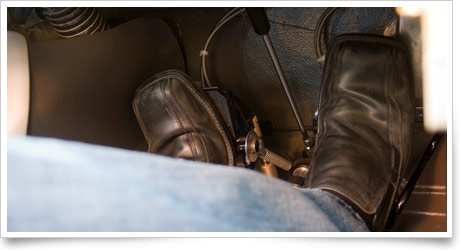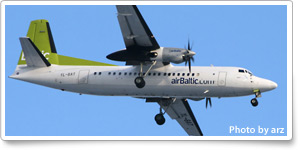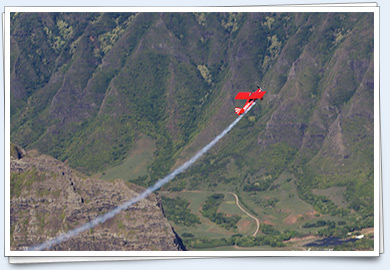|
|||||
Training TipsOne small step
You absorbed those surprises, made the mental adjustment, and got on with learning to fly. (You may not have realized it at the time, but that was your first brush with the law of primacy, a concept that speaks to the power of first impressions in learning.)
There were similarities, too, between aircraft and your familiar modes of ground transportation. On most single-engine aircraft, the brakes are foot-powered, although to use them correctly, you learn to apply pressure to the proper portion of the pedals, because they also control steering and rudder.
Another revelation was that aircraft brakes function independently. If a taxi turn that you have initiated with nosewheel (or tailwheel) steering needs to be tightened, a touch of brake in the desired direction does the job. Mostly, however, you taxi with minimum power and the steering function, avoiding excess braking.
Nosewheel steering also guides the takeoff run until rudder becomes effective; the reverse applies during a landing roll. Braking—except in aircraft with a castering nosewheel—is usually deferred until needed for exiting the runway or coming to a full stop.
Most trainees master the technique quickly, but it only takes a distraction or stress to cause a misstep, with several possible consequences. Inadvertently riding the brakes during takeoff delays acceleration, reducing the safety margin on takeoff from a short runway. On any takeoff, brake pressure applied asymmetrically could induce a swerve, or a complete loss of control.
On landing, touching down with a brake pedal depressed could cause directional control problems or even blow out a tire.
Maintain the proper pedal pressure and position by being seated comfortably at the controls, and by adjusting your foot position on the pedals depending on the operating phase in progress (use a forward motion for steering or rudder, forward and raised to add braking).
"As the airplane starts to roll forward, the pilot should assure both feet are on the rudder pedals so that the toes or balls of the feet are on the rudder portions, not on the brake portions," says Chapter 5 of the Airplane Flying Handbook.
Then relax and fly with a light touch on all the controls. Flight Training NewsFlight Training Excellence finalists announcedAOPA has selected 12 top flight training professionals and 11 flight schools as finalists in its annual Flight Training Awards. A top winner in each category will be named in October at AOPA Aviation Summit 2013 in Fort Worth, Texas. The 2013 awards are drawn from 3,375 respondents who voluntarily reviewed their flight training experience through an AOPA online poll. The process yielded an evaluation of 508 different flight schools and 956 individual flight instructors. Read more >> Jeppesen: An elegantly designed VFR appJeppesen’s Mobile FliteDeck VFR takes a refreshing and seemingly unique stance in the superheated app arms race. Instead of following rival techies who ceaselessly add more features and greater complexity to every version, Jeppesen boldly simplifies its software with an elegant app that presents only essential flight information in a clean, intelligent way. At $49 a year, it also does so cheaply. Read more >> Polk State College to offer aerospace sciences degreeFlorida’s Polk State College announced Sept. 18 that it will offer a new bachelor of science in aerospace sciences degree in fall 2014. The college, with campuses in Bartow, Lake Wales, Lakeland, and Winter Haven, says it is the first public college or university in the state to offer that degree. Read more >> Getting general with aviation appsThere are all kinds of great aviation apps that don’t necessarily fit in the neat categories created for this column. For the third time, AOPA looks at apps that do everything from measure oxygen saturation to provide information on Sling aircraft. Read more >> Should students use tablets in the cockpit?We all love our tablets, particularly when using them in the cockpit or to plan cross-country flights. But should student pilots be using the gadgets during primary training—or should they focus on the basics before moving to high-tech equipment? Join Flight Training Technical Editor Jill Tallman and ePilot Flight Training Edition Editor Benét Wilson at 3 p.m. Eastern on Oct. 1 for the monthly live Flight Training Facebook chat. Tallman and Wilson will discuss training issues with tablets and iPads as well as the latest in apps and tools. See the website to set an email reminder and to view transcripts of previous chats. IMC Club’s Instrument Proficiency Center comes to SummitThe IMC Club, together with Redbird Flight Simulations, will host an instrument proficiency center at AOPA Aviation Summit in Fort Worth, Texas. The Aviation Summit takes place Oct. 10 through 12, and the IMC Club’s IFR Proficiency Center will be open each day from 9 a.m. to 5 p.m. in the Fort Worth Convention Center, and will be available to all instrument-rated pilots and those working on their instrument rating. A special forum headed by IMC Club President Radek Wyrzykowski will kick off each day’s activities. SAFE, Redbird host Pilot Proficiency Project eventThe Society of Aviation and Flight Educators (SAFE) and Redbird Flight Simulations will hold the first Pilot Proficiency Project Oct. 26 and 27. Held in partnership with Starr Aviation, Sennheiser Aviation, and other strategic partners, the weekend event offers pilots affordable proficiency training that combines relevant forums, challenging simulator training sessions, food, and camaraderie. Project activities will qualify for FAA Wings credit for those pilots who are enrolled in the Wings program. FlightSafety expands training sites for CessnasFlightSafety International is offering training for the full line of Citation XL series aircraft in Orlando. It is also adding simulators for the Citation CJ2+ in San Antonio, and the Cessna Caravan equipped with a Garmin G600 avionics suite in Wichita. FlightSafety’s Orlando Learning Center now offers training for the Citation XLS+ using a simulator equipped with a Collins Pro Line 21 avionics suite. The simulator has been qualified to Level D by the FAA, National Civil Aviation Agency of Brazil, Mexico Directorate General of Civil Aviation, and the General Authority of Civil Aviation of Saudi Arabia. Takeoff roll sluggish? Have an abort point picked outWe train on what to do if we lose power during flight. But this concept can also apply to the takeoff roll. If your engine isn’t giving you the performance to get in the air, have a plan in place in case you need to abort your takeoff before you’re even off the ground. Watch this AOPA Live video to determine how to pick an abort point and when to use it. Watch the video >> Training ResourcesAircraft performanceThe typical pilot's operating handbook contains a number of charts that tell you everything you need to know about how your airplane will perform—or do they? Take this Air Safety Institute safety quiz to see how your knowledge of aircraft performance measures up. Log in to take the quiz >>
Did you know that student pilots who join AOPA are three times more likely to complete their flight training? Membership includes unlimited access to aviation information by phone (800/USA-AOPA, weekdays from 8:30 a.m. to 8 p.m. Eastern time) or from Flight Training Online or AOPA Online. If you’re not already a member, join today and get the pilot’s edge.
Federal shutdown looms, AOPA presses CustomsA fiscal showdown in Washington, D.C., may spell more trouble for general aviation. AOPA is fighting another battle against federal efforts to block information on aircraft searches. Also this week, ride back in time in a very special antique aircraft. AOPA Live This Week®, Sept. 26. Career PilotAmerican begins scheduling A319sAmerican Airlines is preparing to start flying the Airbus A319 delivered in July, reports Tulsa World. The aircraft, which will replace the carrier’s current fleet of McDonnell Douglas MD-80s and some Boeing 757s, will fly out of its Dallas-Fort Worth hub to cities including Charlotte, N.C., Cleveland, and Wichita. The A319 was part of a previously announced order of 130 A321s and A319s for delivery through 2017. Republic delays sale of Frontier AirlinesIndianapolis-based Republic Airways Holdings said it has extended the exclusivity sale deadline of Denver-based unit Frontier Airlines. The original date was Sept. 17, but has now been moved to Sept. 30. “Sitting here today, we have made substantial progress towards reaching a definitive agreement with the buyer and, while we can make no assurances, we believe providing the additional time will allow for the process to be completed,” said Republic Airways Chairman, President, and CEO Bryan Bedford in a statement.
For more aviation career news, see the Flight Training website. Plane SpotterBeyond Friendship
Training ProductsASA releases FAR/AIM seriesASA has released the 2014 edition of its FAR/AIM series on the federal aviation regulations. The series is designed for use by pilots, mechanics, and flight crews, and includes the Federal Aviation Regulations/Aeronautical Information Manual (FAR/AIM), the FAR for aviation maintenance technicians and flight crews, FAR and AIM flashcards, and flashcards for the air transport pilot.
Note: Products listed have not been evaluated by ePilot editors unless otherwise noted. AOPA assumes no responsibility for products or services listed or for claims or actions by manufacturers or vendors. Member BenefitsKidney failure and transplantsThe FAA grants special issuance authorizations to airmen who have had certain organ transplants. They require a six-month "period of observation" after the transplantation surgery takes place. The most common organ transplant seen at the FAA is kidney. Log in to read more >> An owner’s cheat sheet to aircraft insuranceInsuring your aircraft is no easy task. It’s a substantial investment, and understanding the ins and outs of the insurance industry can be confusing, to put it mildly. What’s more, comparing insurance policies is rarely an apples-to-apples affair. But to make things a bit easier, here’s a simple checklist to help you navigate the process. Read more >>
CORRECTION: In the Sept. 20 issue of AOPA ePilot Flight Training, we incorrectly identified the date of the death of Wiley Post. Post died Aug. 15, 1935. We regret the error. BlogsWet is dryAs you move into bigger and faster airplanes—especially jets—you need to become aware of things that didn’t necessarily matter as much before, writes blogger Chip Wright. There are new definitions that you need to learn. Besides the various V speeds—V1, V2, VREF, etc.—there are terms that probably didn’t really catch your attention before. Read more >> ATC generation gap?AOPA Foundation President Bruce Landsberg recently discussed whether a new generation of pilots should learn basic stick-and-rudder skills before being entwined by glass and seductions of automation. A new report says that the FAA is going to have a hard time filling the more than 11,700 ATC slots needed in the next eight years. In the interest of streamlining certification, the ASR (or airport surveillance radar) approach is starting to slip away. Is that a “stick-and-rudder skill” for controllers? Read more >> Berkut VLTypically, coaxial rotor systems (one rotor system stacked on top of another that spin in opposite directions) are used on larger helicopters. The advantages are higher speed and more lifting power as a tail rotor is not needed. An aerospace start-up company in India (DASYS), a manufacturer of unmanned aircraft, has designed a light two-seat helicopter with a coaxial rotor system. Read more >> AOPA Career OpportunitiesEver dream of turning your passion for aviation into a career? We’re looking for a web applications developer III, financial analyst, staff assistant/PAC coordinator, and AOPA Live editor/graphic artist. To learn more about other AOPA career opportunities, visit AOPA Online. Community
AVIATION EVENTS & WEATHER
|
||||||||||||||||||||||||||||||||||||

 Remember how strange it seemed to learn that your training aircraft is steered on the ground with foot pedals, and the throttle is worked by hand?
Remember how strange it seemed to learn that your training aircraft is steered on the ground with foot pedals, and the throttle is worked by hand? Fifty-seat turboprops are a common sight at commercial-service airports. A plane spotter with a keen eye for detail may find a casual ramp survey diverted by a high-wing model with a
Fifty-seat turboprops are a common sight at commercial-service airports. A plane spotter with a keen eye for detail may find a casual ramp survey diverted by a high-wing model with a 


